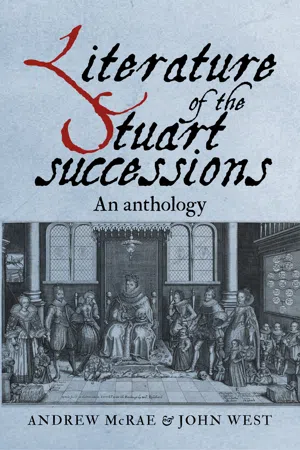![]() Part I: 1603
Part I: 1603![]()
Introduction
When Queen Elizabeth I died, on 24 March 1603, the line of succession was by no means settled. James was unquestionably Elizabeth’s nearest royal relative. Like her, he was a direct descendant of Henry VII of England, and had been installed himself as King of Scotland since his infancy. But he faced multiple rivals, as well as various technical arguments against him, including a legal bar on foreigners inheriting the English throne. Elizabeth herself had not greatly helped, never having made a public declaration on the vexed question of succession. Across the country, the majority of English men and women lived with a sense of this uncertainty hanging heavily upon the realm.
But James himself had worked tirelessly to position himself for the role, and had secured crucial support from within Elizabeth’s Privy Council. Within hours of the Queen’s death, as a result, plans were in place to proclaim James king and to bring him into the country. A letter was rushed north, offering him the crown. The proclamation, printed below, was signed by a range of men occupying prominent positions in the state, including several members of Elizabeth’s Privy Council. It declared James king by ‘law, by lineal succession, and undoubted right’: a statement with an authoritative air, though technically sketchy.
Despite lingering questions surrounding the succession, a potentially tense period of transition passed relatively smoothly. As the material collected below indicates, there were several very good reasons why the English people would have welcomed the new king. Firstly, he was a Protestant, and therefore spared the nation from the violent upheavals of the mid-Tudor years, when the Protestant Edward VI was succeeded by the Catholic Mary I, and she in turn was succeeded by the Protestant Elizabeth. Secondly, he had three children, including the boys Prince Henry (who died in 1612) and Prince Charles. As a result, he offered the stability of dynastic succession. Thirdly, he was already known to many men and women at court, who had been cultivating his favour through the preceding years.
Almost immediately upon him being proclaimed king, significant numbers of courtiers travelled north to greet him. In due course, in April and May, he travelled to London, followed and observed by thousands of his new subjects (events quickly recorded in a newsbook, The True Narration of the Entertainment of his Royal Majesty, from the time of his Departure from Edinbrough; til his Receiving at London). Literature played a part in these festivities. Sir John Davies’s poem ‘The King’s Welcome’ (I.4), to take just one example, was probably recited to James in the course of his journey, after Davies himself had travelled to Scotland. Samuel Daniel’s Panegyrike Congratulatory, not reproduced here, was similarly declared on its title page to have been ‘delivered’ to James in the course of his journey. Meanwhile, in both London and Edinburgh, a wealth of texts was being rushed into print to mark the occasion. Not the least significant were editions of James’s own works of political theory...
